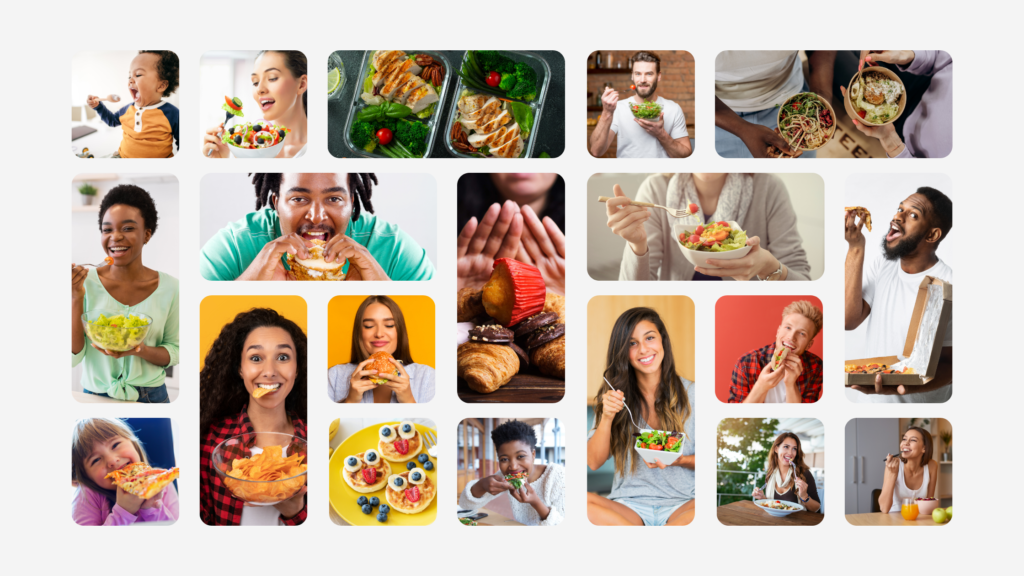As the food industry continues to evolve, meal subscription services are emerging as a major player, offering an enticing alternative to traditional food delivery. While instant food deliveries still dominate the market, an increasing number of consumers are turning to meal subscriptions for reasons that extend beyond convenience. With the integration of cutting-edge technology and an emphasis on meeting consumer demands, the future of meal subscription services is looking more promising than ever.
In this blog, we’ll explore the key trends shaping the future of meal subscription services and how they are using innovative technologies to cater to the evolving needs of consumers.

Why Consumers Are Choosing Meal Subscription Apps Over Instant Deliveries
1. Variety and User Preferences
Meal subscription services provide users with a wide range of options tailored to different dietary needs and preferences. From vegan to keto, gluten-free to high-protein, these services are able to cater to a broad range of tastes, ensuring customers can find something they like.
For instance, Sunbasket offers over 18 different meal plans, accommodating everything from paleo to diabetes-friendly diets. This level of customization ensures that users have a variety of meals to choose from, keeping them engaged and satisfied.
Another example is Snap Kitchen, which focuses on fresh, nutritious meals catering to various dietary preferences. They provide options that are gluten-free, dairy-free, and even meals for those monitoring their sodium intake, allowing customers to meet their specific health goals.
Additionally, Purple Carrot specializes in plant-based meals, featuring a rotating menu that caters specifically to vegan diets. They emphasize fresh, seasonal ingredients, ensuring customers have access to exciting and varied dishes.

2. Healthier and More Conscious Eating
Consumers are growing increasingly health-conscious, and meal subscription apps are responding by offering nutritious, balanced meals. Unlike the typical high-calorie fast food options delivered instantly, these services are centered on fresh, wholesome ingredients.
Calo provides nutritious meal options designed for various dietary preferences, including keto and low-carb. Calo emphasizes balanced nutrition and portion control, ensuring customers can make healthier choices while enjoying delicious meals.
Another noteworthy example is Territory Foods, which offers meals made from locally sourced ingredients designed to be nutritious and satisfying. Their menu includes options catering to dietary preferences like paleo, Whole30, and vegan, emphasizing fresh, whole foods without refined sugars, dairy, or gluten.
Similarly, Snap Kitchen ensures that their meals are not only delicious but also nutritious, using fresh ingredients that are sourced locally.

3. No More “What’s for Dinner” Dilemmas
Meal subscription apps eliminate the daily hassle of deciding what to eat, which is particularly valuable for busy professionals. With these services, users can plan their meals in advance, reducing decision fatigue.
Take HelloFresh, which allows users to pick their meals for the week, ensuring that they never have to worry about last-minute decisions. This feature has helped users save an average of 3.5 hours per week that would otherwise be spent on planning and preparing food.
Green Chef also simplifies meal planning by allowing customers to select meals that fit their specific dietary preferences, such as keto, balanced living, or paleo. This flexibility helps customers avoid the stress of meal planning, ensuring they always have something delicious and healthy on hand.
Additionally, Home Chef offers customizable meal options, allowing users to swap ingredients or choose from various cooking styles, making meal planning even more convenient.

4. Eco-Friendly Packaging and Sustainability
Sustainability is becoming a key consideration for consumers. Many meal subscription services are adopting eco-friendly practices, especially in their packaging. Unlike instant deliveries, which often use non-recyclable materials, these services prioritize sustainable packaging solutions.
Green Chef is known for its commitment to sustainability, using 100% recyclable materials in their packaging. In addition, they offset their carbon footprint, making them the first USDA-certified organic meal kit company.
Hungryroot, takes a similar approach by focusing on eco-friendly practices throughout their supply chain. They use recyclable packaging and source ingredients from sustainable suppliers.
Blue Apron emphasizes minimizing environmental impact through recyclable, reusable, and biodegradable packaging, and has worked to reduce its carbon footprint by sourcing high-quality, sustainable ingredients.

5. Timely, Consistent Deliveries
Meal subscription services are built on reliable, consistent deliveries, offering users peace of mind. Instead of waiting and wondering when their meal will arrive, subscribers receive their meals on a regular schedule.
For instance, Blue Apron ensures that meals arrive fresh and on time, with a well-structured delivery system that allows customers to plan their days around their meals. This level of predictability is a strong selling point for meal subscriptions compared to instant deliveries.
EveryPlate also prioritizes timely deliveries, allowing customers to choose their preferred delivery days and times, making it easy to fit meal preparation into their schedules.
Additionally, Dinnerly guarantees consistent delivery times and provides a reliable meal planning experience, allowing users to enjoy fresh meals without the uncertainty often associated with instant food delivery services.
6. Budget-Friendly Meal Planning
While some might assume meal subscriptions are costly, they can actually be more budget-friendly than daily takeout orders. By subscribing to a weekly or monthly plan, consumers save on per-meal costs and avoid high delivery fees.
EveryPlate is a great example of how meal subscriptions can offer cost-effective solutions. With meals starting at just $4.99 per serving, it caters to families and individuals looking for affordable, nutritious meals without sacrificing quality.
Similarly, Dinnerly provides budget-conscious consumers with meal options starting at just $4.49 per serving, making home cooking accessible without breaking the bank. Their focus on simplicity and value attracts those looking to save money while enjoying home-cooked meals.

7. Tracking Eating Habits
Meal subscription services often come with the added benefit of allowing users to track their eating habits. This feature is especially useful for those focused on fitness or maintaining a specific diet.
Factor offers detailed nutritional information for each meal, allowing users to track their calorie intake, protein levels, and macros. Factor’s data-driven approach helps consumers stay on track with their fitness and dietary goals while enjoying chef-prepared, healthy meals.
Snap Kitchen provides a similar service, allowing users to view nutritional information and track their meals through their app. This transparency helps customers make informed decisions about their food choices.
Furthermore, Trifecta offers a range of organic meals with detailed nutritional data, enabling users to track their macros and stay aligned with their health goals.

How Technology Is Driving the Meal Subscription Revolution
1. AI-Driven Personalization
Many meal subscription services are leveraging AI to offer personalized meal recommendations based on user preferences. These systems learn from previous orders, dietary restrictions, and user feedback to curate meal plans that fit individual needs. Companies like HelloFresh, Sunbasket, and Tovala exemplify this trend, employing sophisticated algorithms to analyze user data and suggest meals tailored to dietary preferences, caloric goals, and taste profiles. By continually adapting to customer choices, these services create a more tailored and enjoyable experience, making meal planning effortless and engaging.
2. Blockchain for Transparency
Transparency is increasingly important in today’s food industry. With blockchain technology, some meal subscription services ensure that consumers know exactly where their ingredients are sourced from, giving them confidence in the quality and sustainability of the food.
For example, Provenance uses blockchain to trace the origin of ingredients used in meal kits, ensuring customers can see exactly where their food comes from and how it was produced. This added transparency builds trust and aligns with the growing consumer demand for ethical sourcing.
In addition to Provenance, larger companies like IBM Food Trust and Walmart are pioneering blockchain solutions for food traceability.
IBM Food Trust utilizes blockchain to create a secure and transparent network for tracking food products from farm to table. Their platform allows companies to share data about their supply chains, enhancing visibility into the origin and journey of food products. This innovation improves food safety by enabling quick identification of contamination sources, ensuring consumers can trace their meals back to their origins.
Walmart has implemented blockchain technology to improve traceability in its supply chain, particularly for fresh produce. By using IBM’s Food Trust blockchain, Walmart can track the journey of products through its supply chain, reducing the time it takes to trace the source of food contamination from days to mere seconds. This not only helps ensure the safety and quality of their food but also increases consumer trust in their products.
In the context of meal subscriptions, blockchain can serve several essential functions:
- Ingredient Verification: Blockchain could be used to verify the authenticity and quality of ingredients used in meal kits, assuring customers they receive what they expect.
- Allergen Tracking: This technology can help track allergens throughout the food production process, ensuring that consumers with allergies can make informed choices.
- Sustainability Tracking: Blockchain can also track the sustainability of ingredients and packaging, enabling consumers to make more ethical choices.
While the use of blockchain in meal subscription companies is still relatively new, its potential to revolutionize the industry by providing greater transparency, traceability, and sustainability is significant. As more companies explore these capabilities, consumers can look forward to a more trustworthy and responsible food sourcing experience.

3. Smart Appliances and Automation
Some companies are combining meal subscriptions with smart appliances to automate the cooking process. This technology integration ensures that meals are prepared with minimal effort and maximum convenience.
Tovala exemplifies this approach by offering a smart oven that syncs with its meal subscription service. Customers simply scan the barcode on their meal kits, and the oven automatically adjusts its settings to cook the meals perfectly. This innovation appeals to busy individuals and families who want the benefits of home-cooked meals without the hassle of traditional cooking methods.
Beyond Tovala, the broader landscape of smart cooking technology includes advancements from companies like Instant Pot, which has introduced smart models that connect with apps for step-by-step cooking guidance tailored to users’ preferences.
Brands like Ninja are also developing multifunctional cookers that offer features such as air frying, pressure cooking, and slow cooking, enabling users to explore various cooking techniques and meal options with ease.

Why Meal Subscription Apps Are the Future
Meal subscription apps are gaining an edge over instant food deliveries by offering tailored meal experiences, healthier options, and sustainability. As technology continues to enhance personalization and transparency, these services are set to dominate the food delivery space. Consumers want more than just convenience—they want variety, reliability, and choices that align with their values and lifestyles.
Ready to Build Your Own Meal Subscription App?
At Wolfpack, we specialize in creating custom meal subscription platforms that are designed to meet your business needs. Whether you’re looking to develop a custom meal subscription platform with AI-driven personalized meal recommendations, implement eco-friendly packaging solutions, or streamline delivery logistics for timely and fresh meals, our team is here to help you stay ahead in the competitive food delivery market.
Check out our blog on Building a Meal Subscription App: Essential Features and Tech Stack for insights into what it takes to create a successful app in this evolving market.
Contact us today to build or improve your meal subscription platform and lead the future of food delivery!
